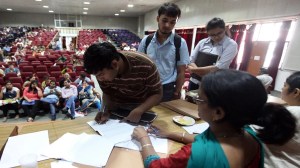- India
- International
‘CRPF used fake surrender youths as guides on anti-Naxal ops’
Sunday Express reported on July 20 that Jharkhand government had asked for a CBI inquiry into “fake surrenders”.
Several of the 514 victims of Jharkhand’s “fake surrender” scandal lodged in Ranchi’s old jail from end-2011 to February 2013 were allegedly taken along by the 203rd Battalion of CRPF’s CoBRA as guides on anti-Maoist operations, sources have said.
The men, mostly adivasi youths from Khunti, Ranchi and Gumla districts, had been allegedly conned by Ravi Bodra, who once worked for the Military Intelligence in Assam, into believing they were paying anything from Rs 30,000 to Rs 2.5 lakh for a backdoor entry into the Army, paramilitary forces and Jharkhand Police
The men were allegedly told to pretend to be extremists, and “surrender” before officials of the CoBRA, a company of which was camped within jail premises, in order to be eligible for government jobs.
The Sunday Express reported on July 20 that the Jharkhand government had asked for a CBI inquiry into the “fake surrenders”. The union Home Ministry is, however, learnt to have declined the request. Sources said the MHA was of the view this was a “cheating case between two private parties and therefore not fit for a CBI inquiry”.
A source in the Jharkhand Police who was privy to the “PSYOP [psychological operation] which did not work out” said the use of the youths as guides for the CoBRA started after the CRPF — which had organised a “Civic Action Camp” with the blessings of the MHA and support of the Jharkhand Police — realised that they had on their hands individuals who claimed to be extremists, but who were in fact only parroting a story that they had been taught.

Senior figures in certain paramilitary forces recommended the police make use of 8-10 adivasi men from the state who had facilitated the surrenders of Bodo militants in Assam, sources in the Jharkhand Police said. The men, all of whom belonged to the Khunti-Porahat region of Jharkhand, had found it easy to operate in Assam because of the good relations they shared with the Bodo families.
The first contact with these men was made in mid-2011. Before Bodra allegedly began luring innocent youngsters, the team — which included Bodra — was trying to get in touch with the men around one of Jharkhand’s most wanted Maoists, Kundan Pahan, in a bid to get him to surrender.
The CRPF usually requests villagers to act as guides for terrain it does not understand, but the villagers almost always have to be coaxed, the sources said. According to the sources, the decision to use the youth in operations was taken after they turned down offers to become Special Police Officers, presumably because it pays considerably less than the regular government jobs that they were expecting, and involves considerable risk.
A senior officer claimed that the youths were never forced to join the anti-LWE operations, and that they had done so on their own.
According to the officer, organisers of the camp got suspicious after not a single genuine case was found after some 100 or 150 cases of “surrenders” were vetted. Bodra, who was known to the state police as Barla, was told that those who were not active extremists would not be taken in and given benefits.
Police sources claimed top leaders of both the CPI (Maoist) and PLFI had contacted them after hearing of the project. “The suspicion (that Bodra was not getting ‘real’ Maoists) was always there. However, the prospect of big Maoist leaders coming over was a bait for us,” admitted an officer who said Bodra had put him in touch with at least one zonal commander of the CPI (Maoist).
The Jharkhand police officer who was the point of contact for CRPF and MHA for the project that led to 514 individuals being presented as Maoists and put in jail, said the operation would have been worth it if it achieved its desired results.
S N Pradhan, ADGP (CID) who was then IG (Special Branch), said what turned out to be a “surrender scam” had begun as an effort to bring youths into the mainstream. “When they saw what we were trying to do, some senior Maoist leaders contacted us. Even if five came, it would have been a grand success for CRPF and police,” he said.
“If you want to implement Track Two — Track One being tactical operations — it can only be done by a long-term PSYOPS process,” he said. “What happened cannot be called surrenders as that implies a technical process. The individual has to be absconding, wanted, and has to have voluntarily offered to surrender.”
Apr 24: Latest News
- 01
- 02
- 03
- 04
- 05






































